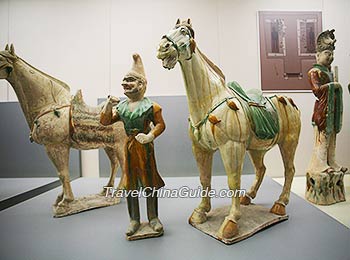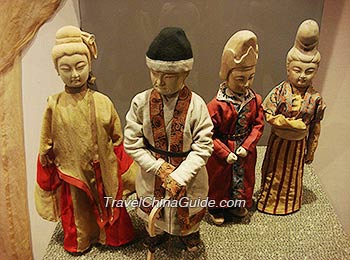Silk Road in Tang Dynasty
 |
| Tri-color Figures of Horses and Groom |
That this time-honored trade route reached its apex in the Tang Dynasty can be ascribed to many reasons. First, the this dynasty was the most powerful in history, and helped the economy to flourish; Chang'an became an international metropolis at that time; many foreign envoys, merchants and missionaries lived in Chang'an. Second, the emperors paid special attention to the management of the vast Western Regions. Third, the mighty countries to the west of the Tang Empire, such as Eastern Roman Empire (Byzantine Empire), Persia and Arabian Empire kept relatively stable. These countries were willing to build good relations with China. All these factors led to trade prosperity along the Silk Road and to frequent cultural exchange between the West and the East.
Silk Road Extended through to the Mongolian Plateau in the North
In the Tang Dynasty, the Silk Road was greatly extended. During the reign of the Tang Taizong, his military force defeated the Eastern Turks in 630, established friendly relations with the Western Turks and vanquished Gaochang (Turpan), Yanqi (Qarashar) and Qiuci (now Kuche). The Tang Empire set up a Protectorate General to Pacify the West (Anxi Daduhufu) in 640, strengthening the dominion of the Western Regions. In 646, the Mobei (now Mongolian Plateau) was under the control of the Tang Dynasty by subduing the Western Turks. Then the road to Mongolian Plateau via Altai appeared, reinforcing contacts between the Mongolian Plateau and the vast Western Regions.
Silk Road Extended through to the Qinghai-Tibet Plateau in the South
 |
| Silk Dress in Tang Dynasty |
Flourish of the Silk Road in Western Regions
With the unification of the Western Regions, branches of the Silk Road sprang up like mushrooms in this area, forming a complex traffic net. Four famous garrisons (Anxi Sizhen): Qiuci, Yanqi, Shule (now Kashgar) and Yutian (Hetian) became the important crossroads of this trade route. At this time, the importance of the Northern Route of the Silk Road reached its peak because it shortened the distance between the East and the West and got rid of the natural barrier of crossing Pamirs. With its prosperity, many boomtowns and market centers appeared along the Northern Route. In 702, the Protectorate General of Beiting was installed with its administration center in Tingzhou (Jimsar), managing the Northern Route of the Silk Road.
After the Anshi Rebellion broke out – the turning point of Tang Dynasty from prosperity to decline, the road started on its downhill path. The western regions were successively controlled by the Tubo (Tibetan Empire), Uyghurs (Huihu) and the Karakhan Empire.
Further Reading: Famous Traveler - Xuanzang